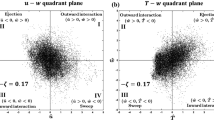Abstract
The quadrant technique, a conditional sampling approach that allocates Reynolds stresses into four different types of events (ejections or bursts, sweeps, inward interactions and outward interactions), is applied to stable marine atmospheric boundary-layer data, collected in the framework of the Coupled Boundary Layer Air—Sea Transfer, Low wind component experiment at Nantucket Island, Massachusetts, USA. The general properties of both scalar and momentum transport are analyzed under the scope of quadrant analysis experimentally and theoretically. It is shown that the third-order Gram–Charlier series is necessary and even sufficient in most of the cases, in describing the experimental time and flux contributions of each quadrant to the total transfer, for both scalar and momentum transport, while the ability of the Gaussian distribution is limited to outlining the general pattern of these quantities. Moreover, a threshold value is applied to the conditional analysis, separating the most important events from the less significant ones and the sensitivity of the flux and especially the time fraction of each quadrant on the choice of this value is presented and discussed. Also, a set of numerically extracted equations, completing the analytical relations, is derived, enabling the prediction of the time and flux fractions of each quadrant, for a wide range of correlation coefficient and threshold values. Finally, the sensitivity of the analysis to the atmospheric stability and the Reynolds averaging scales showed that correlated and uncorrelated motions tend to balance for increasingly stable conditions and/or for large time scales.
Similar content being viewed by others
References
Antonia RA (1981) Conditional sampling in turbulence measurements. Ann Rev Fluid Mech 13:131–156
Begstrom H, Hogstrom U (1989) Turbulent exchange above a pine forest II: organized structures. Boundary-Layer Meteorol 49:231–263
Bogard DG, Tiederman WG (1986) Burst detection with single-point velocity measurements. J Fluid Mech 162:389–413
Boppe RS, Neu WL (1995) Quasi-coherent structures in the marine atmospheric surface layer. J Geophys Res 100(C10):20635–20648
Boppe RS, Neu WL, Shuai H (1999) Large-scale motions in the marine atmospheric surface layer. Boundary-Layer Meteorol 92:165–183
Cantwell B (1981) Organized motion in turbulent flow. Ann Rev Fluid Mech 13:457–515
Frenkiel F, Klebanoff P (1967) Higher order correlations in a turbulent field. Phys Fluids 10:507–520
Hogstrom U, Bergstrom H (1996) Organized turbulence structures in the near-neutral atmospheric surface layer. J Atmos Sci 53:2452–2464
Katul G, Kuhn G, Schieldge J, Hsieh C-I (1997) The ejection-sweep character of scalar fluxes in the unstable surface layer. Boundary-Layer Meteorol 83:1–26
Mahrt L, Vickers D, Howell J, Hojstrup J, Wilczak J, Edson J, Hare J (1996) Sea surface drag coefficients in the Riso Air Sea Experiment. J Geophys Res 101(C6):14,327–14,335
Maitani T, Ohtaki E (1987) Turbulent transport process of momentum and sensible heat in the surface layer over paddy field. Boundary-Layer Meteorol 40:283–293
Maitani T, Shaw RH (1990) Joint probability analysis of momentum and heat fluxes at deciduous forest. Boundary-Layer Meteorol 52:283–300
Nagakawa H, Nezu I (1977) Prediction of the contributions to the Reynolds stress from bursting events in open-channel flows. J Fluid Mech 80:99–128
Raupach MR (1981) Conditional statistics of Reynolds stress in rough-wall and smooth-wall turbulent boundary layers. J Fluid Mech 108:363–382
Robinson SK (1991) Coherent motions in the turbulent boundary layer. Ann Rev Fluid Mech 23:601–639
Shaw RH (1985) On diffusive and dispersive fluxes in forest canopies. In: Hutchinson BA, Hicks BB (eds) The forest-atmosphere interaction. D. Reidel Publishing Company, Dordrecht, pp 407–419
Shaw RH, Tavangar J, Ward DP (1983) Structure of Reynolds stress in a canopy layer. J Clim Appl Meteorlol 22:1922–1931
Wang Q, Helmis CG, Gao Z, Kalogiros J, Wang S (2004) Variations of boundary layer mean and turbulence structure using synthesized observations. 16th symposium on boundary layers and turbulence, 9–14 August, Portland, ME. (http://ams.confex.com/ams/pdfpapers/78415.pdf)
Willmarth WW, Lu SS (1974) Structure of the Reynolds stress and the occurrence of bursts in the turbulent boundary layer. Adv Geophys 18A:287–314
Author information
Authors and Affiliations
Corresponding author
Rights and permissions
About this article
Cite this article
Katsouvas, G.D., Helmis, C.G. & Wang, Q. Quadrant analysis of the scalar and momentum fluxes in the stable marine atmospheric surface layer. Boundary-Layer Meteorol 124, 335–360 (2007). https://doi.org/10.1007/s10546-007-9169-6
Received:
Accepted:
Published:
Issue Date:
DOI: https://doi.org/10.1007/s10546-007-9169-6




